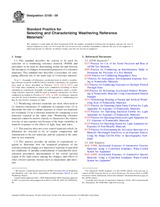We need your consent to use the individual data so that you can see information about your interests, among other things. Click "OK" to give your consent.
ASTM E1417/E1417M-13
Standard Practice for Liquid Penetrant Testing
STANDARD published on 1.6.2013
The information about the standard:
Designation standards: ASTM E1417/E1417M-13
Note: WITHDRAWN
Publication date standards: 1.6.2013
SKU: NS-41696
The number of pages: 11
Approximate weight : 33 g (0.07 lbs)
Country: American technical standard
Category: Technical standards ASTM
The category - similar standards:
Annotation of standard text ASTM E1417/E1417M-13 :
Keywords:
dye liquid penetrant examination, dye penetrant examination, fluorescent liquid penetrant examination, fluorescent penetrant examination, liquid penetrant examination, liquid penetrant testing, nondestructive, nondestructive evaluation, nondestructive examination, nondestructive testing, penetrant examination, penetrant testing, ICS Number Code 19.040 (Environmental testing)
Additional information
| Significance and Use | ||||||||||||||||||||||||||||
|
4.1 This practice establishes the basic parameters for controlling the application of the liquid penetrant method. This practice is written so it can be specified on the engineering drawing, specification, or contract. It is not a detailed how-to procedure to be used by the inspector and, therefore, must be supplemented by a detailed procedure that conforms to the requirements of this practice. Specification E165 contains information to help develop detailed requirements. |
||||||||||||||||||||||||||||
| 1. Scope | ||||||||||||||||||||||||||||
|
1.1 This practice establishes the minimum requirements for conducting liquid penetrant examination of nonporous metal, and nonmetal components. 1.2 The penetrant examination
processes described in this practice are applicable to in-process,
final, and maintenance (in-service) examinations. These processes
are applicable for the detection of discontinuities, such as lack
of fusion, corrosion, cracks, laps, cold shuts, and porosity, that
are open or connected to the surface of the component under
examination.
1.3 Caution must be exercised in the usage of elevated temperature with components manufactured from thermoplastic materials. Also, some cleaners, penetrants, and developers can have a deleterious effect on nonmetallic materials such as plastics. Prior to examination, tests should be conducted to ensure that none of the cleaning or examination materials are harmful to the components to be examined. 1.4 Units—The values stated in either SI units or inch-pound units are to be regarded separately as standard. The values stated in each system may not be exact equivalents; therefore, each system shall be used independently of the other. Combining values from the two systems may result in non-conformance with the standard. 1.5 All areas of this practice may be open to agreement between the cognizant engineering organization and the supplier, or specific direction from the cognizant engineering organization. 1.6 This standard does not purport to address all of the safety concerns, if any, associated with its use. It is the responsibility of the user of this standard to establish appropriate safety and health practices and determine the applicability of regulatory limitations prior to use. |
||||||||||||||||||||||||||||
| 2. Referenced Documents | ||||||||||||||||||||||||||||
|
Similar standards:
Historical
15.12.2012
Historical
1.6.2013
Historical
1.6.2009
Historical
1.11.2012
Historical
1.6.2013
Historical
1.12.2009
We recommend:
Technical standards updating
Do you want to make sure you use only the valid technical standards?
We can offer you a solution which will provide you a monthly overview concerning the updating of standards which you use.
Would you like to know more? Look at this page.



 ASTM G154-12a
ASTM G154-12a ASTM G155-13
ASTM G155-13 ASTM G156-09
ASTM G156-09 ASTM G160-12
ASTM G160-12 ASTM G169-01(2013)..
ASTM G169-01(2013).. ASTM G201-09
ASTM G201-09
 Cookies
Cookies
